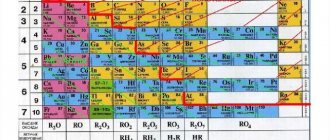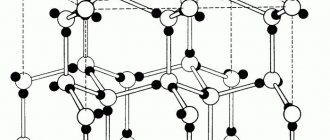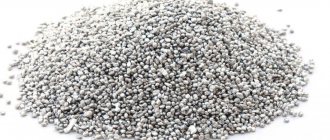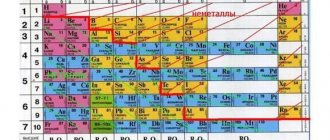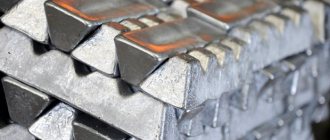How does the electrical conductivity of different metals differ?
The electronic theory of electrical conductivity of metals was developed in the research of Paul Drude. He was able to discover such a property as resistance, which is observed when electric current passes through a conductor. In the future, this will make it possible to classify different substances according to their conductivity level. From the results obtained, it is easy to understand which metal is suitable for the manufacture of a particular cable. This is a very important point, since incorrectly selected material can cause a fire as a result of overheating from the passage of excess voltage current.
Classical theory of electrical conductivity of metals
The basic principles of the theory of electrical conductivity of metals contain six points. First: a high level of electrical conductivity is associated with the presence of a large number of free electrons. Second: electric current arises through external influence on the metal, during which electrons move from random motion to ordered motion.
Third: the strength of the current passing through a metal conductor is calculated according to Ohm's law. Fourth: different numbers of elementary particles in the crystal lattice lead to unequal resistance of metals. Fifth: electric current in the circuit arises instantly after the start of exposure to electrons. Sixth: as the internal temperature of the metal increases, the level of its resistance also increases.
The nature of the electrical conductivity of metals is explained by the second point of the provisions. In a quiet state, all free electrons rotate chaotically around the nucleus. At this moment, the metal is not able to independently reproduce electrical charges. But as soon as you connect an external source of influence, the electrons instantly line up in a structured sequence and become carriers of electric current. With increasing temperature, the electrical conductivity of metals decreases.
This is due to the fact that the molecular bonds in the crystal lattice weaken, elementary particles begin to rotate in an even more chaotic order, so the formation of electrons in a chain becomes more complicated. Therefore, it is necessary to take measures to prevent overheating of the conductors, as this negatively affects their performance properties. The mechanism of electrical conductivity of metals cannot be changed due to the current laws of physics. But it is possible to neutralize negative external and internal influences that interfere with the normal course of the process.
The best conductors of electric current: characteristics of substances that transmit electricity
When using electrical appliances, a person constantly encounters substances that are conductors, semiconductors and dielectrics that do not conduct current. These materials differ in the degree of electrical conductivity. In order to work with household appliances, you need to know all their features and characteristics. You can choose the best conductor of electric current from metals.
- Features of the concept
- First and second kind
- Processes in electrical conductors
Current conductors are those substances in which the number of free electrical charges exceeds the number of bound ones. They may begin to move under the influence of an external force. The state of materials can be gaseous, solid and liquid. Electricity can flow through a metal wire if it is connected between two conductors of different potentials.
The current is carried by electrons that are not connected by atoms. They are the ones who are able to characterize the ability of an object to pass electrical charges through itself, or the amount of current conductivity. Its value is inversely proportional to the resistance, it is measured in siemens: cm = 1/Ohm.
The main carriers of electricity in nature are ions, holes and electrons. Therefore, conductivity ability is divided into three types:
- ionic;
- electronic;
- hole
The applied voltage makes it possible to evaluate the quality of the conductor. This ability of a substance is also called the current-voltage characteristic.
First and second kind
After you have figured out what conducts electric current, you need to find out the characteristics of some substances. Conductors can be different - metal wire, sea water. But the current in them differs, so substances are divided into two groups:
- the first kind, in which electricity flows through electrons;
- the second type is based on ions.
The former include all metals and carbon. The second type includes alkalis, acids, and molten salts—electrolytes. In them, the current represents the ordered movement of negative and positive ions. Electricity flows in such materials at any voltage level. Under normal conditions, a good conductor of electric current is a product made of gold, silver, aluminum or copper.
The latter two materials produce cables that are low cost. A high-quality liquid substance that conducts current is mercury, and current flows well through carbon. But this substance is not flexible, so it is not used in practice. Although physicists have recently been able to imagine carbon in the form of graphene, which has made it possible to make cords from its threads.
Graphene products have such a resistance that it is unacceptable for conductors. They can only be used in heaters. In this case, metal wires made of nickel and chromium lose out, since they cannot withstand very high temperatures. Spirals in fluorescent lamps are made of tungsten. This material is capable of heating up, since the substance is refractory.
Processes in electrical conductors
During the flow of electricity, the conductor comes under a certain influence. The most important thing is the increase in temperature. They also release some chemical reactions that can change the physical properties of a substance. Conductors of the second kind are most exposed to this influence. A chemical reaction occurs in them, which is called electrolysis.
The ions of substances near the electric poles receive the necessary charge and restore the original state that they had before the formation of an alkali, acid or salt. Using electrolysis, chemists and physicists can produce pure chemicals from natural raw materials. Aluminum and other types of metals are created in this way.
Substances of the first and second kind participate in processes other than conduction of electricity. For example, when acid reacts with lead, a chemical reaction occurs that causes the release of current. All batteries work on this principle.
The conductors of the first group may change when in contact with each other. During operation, copper and aluminum must be covered with a special shell, otherwise both metals will simply melt. Humid air will cause an electrochemical reaction to occur.
Therefore, the conductors are coated with a layer of varnish or other protective material.
Some conductors cannot resist electricity in cold air. This phenomenon is called superconductivity, which corresponds to a temperature value close to the chemical state of liquid helium. But research has led to the fact that there are new conductors with high temperatures.
Such substances were discovered in the 20th century. Ceramics made of oxygen, barium, copper and lanthanum do not conduct current under normal conditions, but when heated they become superconductors . In practice, it is advantageous to use substances that can transmit electricity at 58 degrees Kelvin and above, a temperature above the boiling point of nitrogen.
Liquids and gases that conduct current are used less often than solids. But they are also necessary for the manufacture of modern electrical appliances.
Source: https://220v.guru/elementy-elektriki/provodka/luchshie-provodniki-elektricheskogo-toka.html
Metals with high electrical conductivity
The electrical conductivity of alkali metals is at a high level, since their electrons are weakly attached to the nucleus and easily line up in the desired sequence. But this group is characterized by low melting points and enormous chemical activity, which in most cases does not allow their use for the manufacture of wires.
Metals with high electrical conductivity when opened are very dangerous for humans. Touching a bare wire will result in an electrical burn and a powerful discharge to all internal organs. This often results in instant death. Therefore, special insulating materials are used for the safety of people.
Depending on the application, they can be solid, liquid or gaseous. But all types are designed for one function - isolating the electrical current inside the circuit so that it cannot affect the outside world. The electrical conductivity of metals is used in almost all areas of modern human life, so ensuring safety is a top priority.
The metal with the highest electrical conductivity is?
The metal with the highest electrical conductivity is? 1) Iron 2) copper 3) silver 4) aluminumSilver has the highest electrical conductivity. comment add to favorites link thank Do you know another answer? Other chemistry questions URGENTLY, PLEASE, WRITE SOMEONE, I REALLY NEED IT, I WILL BE VERY THANKFUL! I HAVE ALREADY SENT THIS TASK 50 TIMES, WRITE SOMEONE, PEOPLE! IT'S ONLY CORRECT, WHO KNOWS WHAT! I WILL GIVE 10 POINTS, ONLY CORRECTLY, REALLY NECESSARY, PEOPLE! |
tutreshu.ru
Physical meaning of conductivity
The use of metal conductors has a long history. Scientists and engineers working in fields of science and technology that use electricity have long decided on materials for wires, terminals, contacts, printed circuit boards, etc. A physical quantity called electrical conductivity helps determine the most electrically conductive metal in the world.
The concept of conductivity is the inverse of electrical resistance. The quantification of conductivity is related to the unit of resistance, which is measured in Ohms in the International System of Units (SI). The SI unit of electrical conductivity is siemens. The Russian designation for this unit is Cm, the international designation is S. An electrical conductivity of 1 Cm has a section of an electrical network with a resistance of 1 Ohm.
Conductivity
The measure of a substance's ability to conduct electric current is called electrical conductivity. The most electrically conductive metal has the highest similar indicator. This characteristic can be determined for any substance or environment instrumentally and has a numerical expression. The specific electrical conductivity of a cylindrical conductor of unit length and unit cross-sectional area is related to the resistivity of this conductor.
The system unit for conductivity is siemens per meter – S/m. To find out which metal is the most electrically conductive metal in the world, it is enough to compare their experimentally determined conductivities. You can determine the resistivity using a special device - a microohmmeter. These characteristics are inversely dependent.
What is the resistance of copper and aluminum
Aluminum is a lightweight metal that can be easily machined and cast. It has high electrical conductivity: it ranks 4th after silver, copper and gold.
Important! Despite a number of advantages (low cost, light weight, ease of processing, and others), in the long term, aluminum wires are less profitable than copper wires. In electrical engineering, 2 terms have meaning:
In electrical engineering, 2 terms have meaning:
- Conductivity: Responsible for the transfer of current from one point to another. The higher the conductivity of a metal, the better it transmits electricity. At +20 degrees, the conductivity of copper is 59.5 million siemens per meter (S/m), aluminum - 38 million S/m. The conductivity of a copper cable is practically independent of temperature.
- Electrical resistance: the higher this concept, the worse the substance will pass current. The resistivity of copper is 0.01724-0.0180 μOhm/m, aluminum - 0.0262-0.0295.
In other words, copper has higher conductivity and lower resistance than aluminum.
Conductivity of metals
The very concept of electric current as a directed flow of charged particles seems more harmonious for substances based on crystal lattices characteristic of metals. Charge carriers when an electric current occurs in metals are free electrons, and not ions, as is the case in liquid media. It has been experimentally established that when a current occurs in metals, there is no transfer of particles of matter between the conductors.
Metallic substances differ from others by having looser bonds at the atomic level. The internal structure of metals is characterized by the presence of a large number of “lonely” electrons. which, at the slightest influence of electromagnetic forces, form a directed flow. Therefore, it is not for nothing that metals are the best conductors of electric current, and it is precisely such molecular interactions that distinguish the most electrically conductive metal. Another specific property of metals – high thermal conductivity – is based on the structural features of the crystal lattice of metals.
metals have high electrical conductivity - from English to Russian
- Metals are simple substances that, under normal conditions, have characteristic properties: high electrical and thermal conductivity, negative temperature coefficient of electrical conductivity, the ability to reflect electromagnetic waves well... ... Great Soviet Encyclopedia
- METALS - (from the Greek metallon, originally mine, ore, mines), simple in nature, which under normal conditions have characteristic properties: high electrical and thermal conductivity, negative temperature coefficient. electrical conductivity, good ability... ... Physical encyclopedia
- Precious metals - (Precious metals) Precious metals are rare metals that are distinguished by their brilliance, beauty and resistance to corrosion History of the extraction of precious metals, varieties, properties, applications, distribution in nature, alloys... ... Investor's Encyclopedia
- Liquid metals are opaque liquids with a characteristic luster that have high thermal conductivity, electrical conductivity, and other features characteristic of solid metals (See Metals). F. m. are all molten metals and metal alloys, as well as ... ... Great Soviet Encyclopedia
- LIQUID METALS are opaque liquids that have high thermal and electrical conductivity, as well as other properties characteristic of TV. metals J. m. yavl. everything melted metals and metal alloys with a number of metallides. Some semimetals and semiconductors... ...Physical Encyclopedia
- ALKALINE EARTH METALS - SUBGROUP IIA BERYLLIUM, MAGNESIUM AND ALKALINE EARTH METALS CALCIUM, STRONTIUM, BARIUM, RADIUM Strictly speaking, this subgroup consists of two types of elements. Beryllium and magnesium elements of short periods are more similar to each other than to the other four... ... Collier's Encyclopedia
- Cyclotron resonance is the selective absorption of electromagnetic energy by charge carriers in conductors placed in a magnetic field at frequencies equal to or multiples of their cyclotron frequency (See Cyclotron frequency). When Ts. r. there is a sharp increase... ... Great Soviet Encyclopedia
- Metal - (Metal) Definition of metal, physical and chemical properties of metals Definition of metal, physical and chemical properties of metals, application of metals Contents Contents Definition Finding in nature Properties Characteristic properties... ... Investor's Encyclopedia
- Copper - (Copper) Metal copper, deposits and mining of copper, production and use Information about the metal copper, properties of copper, deposits and mining of metal, production and use of copper Contents - (lat. Cuprum), Cu, chemical element of group I... ... Encyclopedia investor
- Aluminum - (Aluminum) Alloys and production of aluminum, general characteristics of Al. Physical and chemical properties of aluminum, production and occurrence of Al in nature, use of aluminum Contents Contents Section 1. Name and history of discovery. Section 2. General... ... Investor's Encyclopedia
- A solid is one of the four states of aggregation of matter, differing from other states of aggregation (liquids (See Liquid), Gases, plasma (See Plasma)) by the stability of its shape and the nature of the thermal motion of atoms that perform small oscillations around ... ... Great Soviet Encyclopedia
translate.academic.ru
Top best conductors – metals
4 metals that are of practical importance for their use as electrical conductors are distributed in the following order relative to the value of specific conductivity, measured in S/m:
- Silver – 62,500,000.
- Copper – 59,500,000.
- Gold – 45,500,000.
- Aluminum - 38,000,000.
It can be seen that the most electrically conductive metal is silver. But like gold, it is used to organize the electrical network only in special specific cases. The reason is high cost.
But copper and aluminum are the most common option for electrical appliances and cable products due to their low resistance to electric current and affordability. Other metals are rarely used as conductors.
Factors affecting the conductivity of metals
Even the most electrically conductive metal reduces its conductivity if it contains other additives and impurities. Alloys have a different crystal lattice structure than “pure” metals. It is characterized by a violation of symmetry, cracks and other defects. Conductivity also decreases with increasing ambient temperature.
The increased resistance inherent in alloys is used in heating elements. It is no coincidence that nichrome, fechral and other alloys are used to manufacture working elements of electric furnaces and heaters.
The most electrically conductive metal is precious silver, mostly used by jewelers, for minting coins, etc. But its special chemical and physical properties are also widely used in technology and instrument making. For example, in addition to being used in components and assemblies with reduced resistance, silver plating protects contact groups from oxidation. The unique properties of silver and alloys based on it often make its use justified, despite its high cost.
